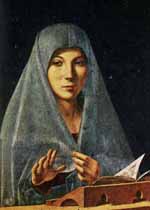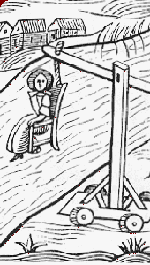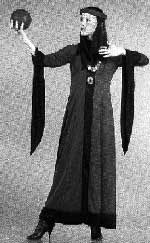The Medieval World
Medieval World Information
News
- coming soon
Links
Site Info
Welcome, Guest
Court depositions in 16th century English witch trials

It is unlikely that the reported cases of witchcraft represent reliable evidence on the practices of "witches." However, court depositions in witch trials can contribute to a study of the history of beliefs about witchcraft.
The European anti-witch paranoia of the time was found to a much lesser degree in England, with about a thousand executions between 1542 and 1684[1]. English witch trials became increasingly prevalent from the 1540s, peaked in the last two decades of the 16th century, then declined generally, with a brief revival in the 1640s in East Anglia, as well as occasional localised outbursts of persecution. Even in 1584, there was evidence of some scepticism that witches were anything other than despised old women.[2]
The chronology of the relevant legislation reflected the growth of concern over witchcraft from the 1540s onwards. The main relevant Acts were passed in 1542 (repealed in 1547) 1563 and 1604. They prescribed a range of punishments, of which death by hanging was the most extreme. The last execution in England (Alice Molland) took place in 1684 and the last trial (Jane Wenham) in 1712

Witchcraft cases were prosecuted in a range of courts: church courts, borough courts, quarter sessions or assizes. The assizes were most significant - six circuits meeting twice annually, with both criminal and civil courts. Each type of court had its own procedures and rules of evidence and standards of evidence varied widely from one court to another. Survival of the records is geographically uneven and only about three quarters of files from before 1645 remain. The records cannot therefore be seen as comprehensive or even representative of the trials in general.
Formal trials were only one of many ways to take activity against witches. A court case was beyond the means of most people who felt themselves threatened by a local witch and would be more likely to resort to "community action." Hence, the legal evidence represents only a sample of a much wider range of anti-witch activity.[3]
Nevertheless, legal records can provide insights as to the characteristics that could lead to an individual being branded a witch; to the time scale of persecution; to local variations in the level of persecutions; to the outcomes of trials and to the modes of thought that underpinned the trials.
The Home Circuit (the assizes in Essex, Hertfordshire, Kent, Surrey, Sussex) saw 785 cases involving 474 "witches" between 1558 and 1709. Only 44% of accused witches were convicted (209) but half of those convicted were hanged (104).The cases were concentrated in Essex, where 60% of prosecutions took place. The first major English trial took place in Essex, near Chelmsford, in 1566.

No evidence of pagan practices had been presented In an earlier (1563) Essex case tried in an archbishop's court. According to the witness, Philippa Gale, Elizabeth Lewis had killed John Barnard's wife by witchcraft after Mistress Barnard had referred to the rumour that Elizabeth was a witch. One accuser, Agnes Devenishe, reported that she had actually sought Elizabeth's advice about a sore arm, on the basis of these rumours. In this case, the evidence had consisted of a combination of rumours and a list of misfortunes suffered by people who had commercial quarrels with Elizabeth.[4]
However, by the time of the 1566 case (Elizabeth Francis, Agnes Waterhouse, Joan Waterhouse) the "witches" were producing "confessions" that matched general beliefs about witchcraft. These included calling for Satan's aid; having a cat as a familiar; causing financial ruin and death as revenge on an unwilling suitor; causing lameness to her husband. These features - the familiar and the acts of maleficium (personal spite) were common to both English and continental trials. [5] However, in contrast to the usual pattern in European trials, no reference was made to a pact with the devil or a sabbat. Elizabeth Francis was imprisoned for 12 months, on the sole evidence of her confession. She was later twice charged with witchcraft and was hanged in 1579, in another major witch trial. However, the justification for the hanging was that she had caused personal injury rather than that she had committed heresy. [6]
By 1583, in the Chelmsford trial of the St Osyth witches, it was becoming routine to search for "witch marks" and to accept hearsay, rumour and the testimony of children as young as six as constituting proof.
In 1604, James I's new anti-witch law made hanging mandatory, introduced trial by torture and stressed the idea of a covenant with the devil as the central issue, more closely following the Catholic European approach. However, even James came to recognise the falsity of accusations. In the last 9 years of his reign, only 9 people were hanged. By this time, scepticism was more widespread, although some of the worst excesses of English witch hunting took place after this time, in 1645, in Essex, when Matthew Hopkins carried out numerous tortures and hangings.
Witchcraft trial records have little value for determining the existence of any self-identified witches but they can provide illuminating evidence of the implications of particular current belief systems. They show how sophisticated legal mechanisms may be brought to bear to scapegoat unpopular individuals. They raise questions about which social, political, religious, economic, cultural or legal factors differentiated the English trials from the far more horrific Scottish and German equivalents, given that all European countries shared general beliefs derived from the Malleus Malficarum.
Bibliography and further reading
Glucklich, A., (1997) The End of Magic, New York & Oxford, Oxford University Press.
Hart, R (1971) Witchcraft, London, Wayland.
Malleus Malficarum. Extract at www.malleusmalficarum.org
Macfarlane, A. (1999) Witchcraft in Tudor and Stuart England : a regional and comparative study. London : Routledge,
Oldridge, D., (2002) The Witchcraft Reader, London & New York, Routledge
Purkiss, D., (1996) The Witch in History, London & New York, Routledge.
Scot, R., (1584)Discoverie of Witchcraft , London
Sharpe, J.A.,(2001) Witchcraft in early modern England, Harlow, Longman
Trevor-Roper H., (1967) The European Witch Craze of the 16th and 17th Centuries
Digital Mirror - Archives, Witchcraft in Flintshire
Taylor, S Devil in a Blue Dress: Women, Inherent Evil, and the Sin of Witchcraft
Footnotes
[1] Hart, R, 1971: 87
[2] Scot, Reginald, 1584, wrote that those likely to be accused of witchcraft were usually feared and despised unsociable old women. He expressed a very modern and sceptical viewpoint on the witch trials.
[3] Sharpe, J.A 2001
[4] Sharpe, J.A, 2001
[5] Hart, 1971: 93
[6] Hart, 1971: 97